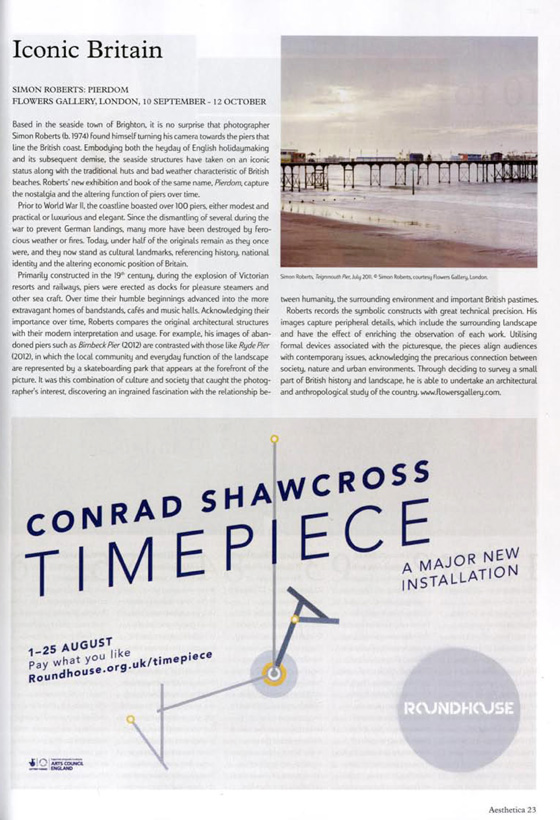We English by Simon Roberts, “Banal Nationalism” in Landscape? is a journal article by Karine Chambefort-Kay, Université Paris-Est Créteil, from the new issue of Journée d’études, entitled “The American and British Nations in Contemporary Landscape Photography” (December 2014)
Abstract
This paper studies the case of a landscape photography project by British photographer Simon Roberts: We English—the project comprising the book published by Chris Boot in 2009, exhibitions of the large format prints of the photographs, and the artist’s dedicated website with a blog and forum for the public to propose subjects. We address the question of English national identity in Simon Roberts’s photos through the concept of “banal nationalism” coined in 1995 by Michel Billig. The first part draws on Billig’s thesis that the nation is “flagged” in the most banal everyday environment and activities, and discusses whether Simon Roberts’s documentary photographs evidence such subliminal national “flagging”. The second part shows the limits of the concept of “banal nationalism” when studying We English because of the complex, collaborative and reflexive nature of the project. By revealing how personal and intertextual references inform both the photographer’s and the viewer’s perception, the artist documents the dialectical process and negotiations at work in national identification. The third part contends that this dynamic approach of Englishness allows Roberts to propose his own re-imagining of the homeland.
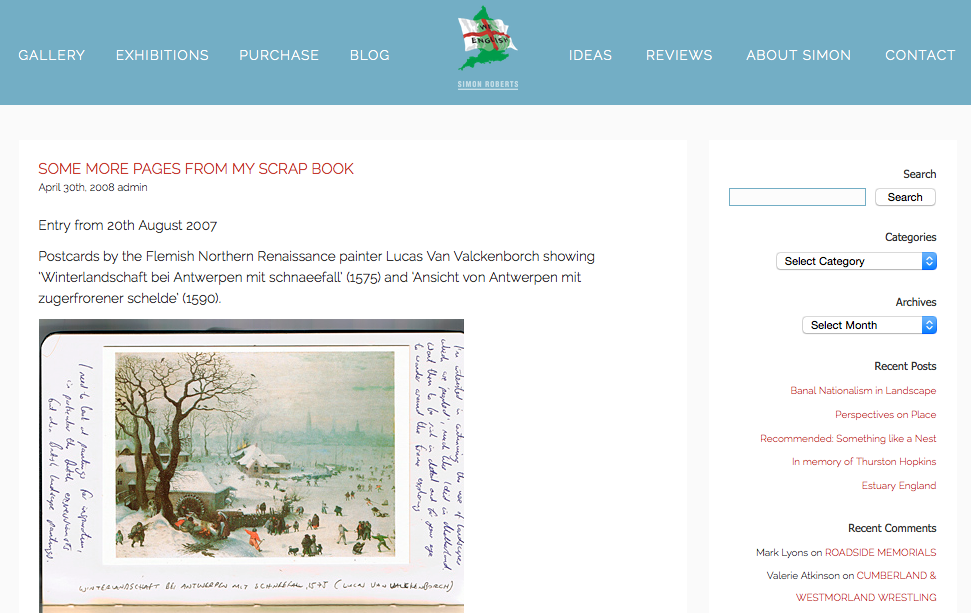
On writing about my working practice for the project, Chambefort-Kay comments:
“A vast framework of references is the backbone of the whole project, and it is made visible through various devices. Simon Roberts opts for transparency on the genealogy of his pictures and on his authorial choices. He questions himself and his audience on the cultural filters and the modes of perception that inform their understanding of landscape. Therefore it is crucial to take into account the whole project, that is, to include both the blog and the pictures in our analysis to appreciate the full scope and impact of We English. Beyond merely documenting the English outdoors, Simon Roberts reveals the different ways in which people connect with the landscape both in nature and in pictures. He offers an insight into the mechanisms through which the national community is constantly re-created in landscape, showing that everything is negotiated individually and collectively.”
And in conclusion, writes:
“We English offers a renewed vision of England. New forms of cohesion and belonging are evidenced, but they are not exclusively found in urban areas. Simon Roberts does not reject the national frame, but reinvents it, by revealing the interactions and relations involved in national identification. The photographs of We English and the whole project actually display the openness of conviviality, which “makes a nonsense of closed, fixed and reified identity and turns attention toward the always unpredictable mechanisms of identification” (Gilroy, 2005, xvi). The nation is re-imagined through a new, dynamic, open vision of England.”
You can download a pdf of the full article here.
Chambefort-Kay recently completed a PhD entitled “Ecritures photographiques des identités collectives, Grande-Bretagne, 1990-2010”, which deals with many British photographers and exhibitions from the period and includes some chapters about We English and The Election Project.
Perspectives on Place by J.A.P Alexander is a new book exploring the history of landscape photography and looks critically at how contemporary photographers continue to find new and innovative ways of engaging with the landscape and their surroundings. It looks at the visual approaches that have been adopted by photographers and artists to facilitate the communication of ideas and themes, as well as more abstract concepts. Practical issues, such as effective composition and managing challenging lighting conditions are also discussed.
Alexander references We English in the chapter Landscape and Power – Inspiring Nationhood. He writes:
“Simon Roberts’s major project We English is a survey of the contemporary English landscape and picks out peculiarities and eccentricities, as well as more commonplace activities of its inhabitants. While the project is likely to be immediately accessible to British audiences, there is a danger this kind of project might leave foreign audiences at loss as to how to interpret the subject matter or even how to confine a nation to conformed stereotypes.
Roberts’s work has been compared to Martin Parr’s Think of England (2001), which isolates English stereotypes more explicitly. Roberts’s photographs are, of course, created and read in a landscape paradigm. The photographer looks specifically at the diversity of English leisure activities in relation to the landscape, ranging from the bizarre – the annual Mad Maldon Mud Race in Essex – to the intimate – Roberts’s photograph of the South Downs in Sussex shows what we assume is a young couple relaxing in a field, a curious echo of the pastoral motif of young villagers courting. As well as the presentation of clichés, such as the couple picnicking barely a few meters away from their car in the Yorkshire Dales, Roberts challenges stereotypes about the English landscape.”
The group exhibition ‘Show Me The Money’ is shortly about to open at its first tour location, John Hansard Gallery. More details here.
In the meantime, you can watch a film about the exhibition made by AHRC here.
And here are some reviews….
“What is most striking about this exhibition is its breadth and its inventiveness.”
FT Weekend, 2014. Read here.
“Simon Roberts, an incisive and powerfully expressive artist, uses the surrealist tactic of juxtaposing found text, graphs and images to expose and undermine the contradictions and deceptions of the 2008 financial crisis in his Credit Crunch Lexicon. And in a fine photograph, taken in the late autumn of 2011, Roberts shows a TV monitor with a reporter, almost hidden in a bank of screens on a trading station inside Lloyds Bank, reporting on the public-sector pensions strike. “
Mike Quillle, The Morning Star, 2014. Read here.
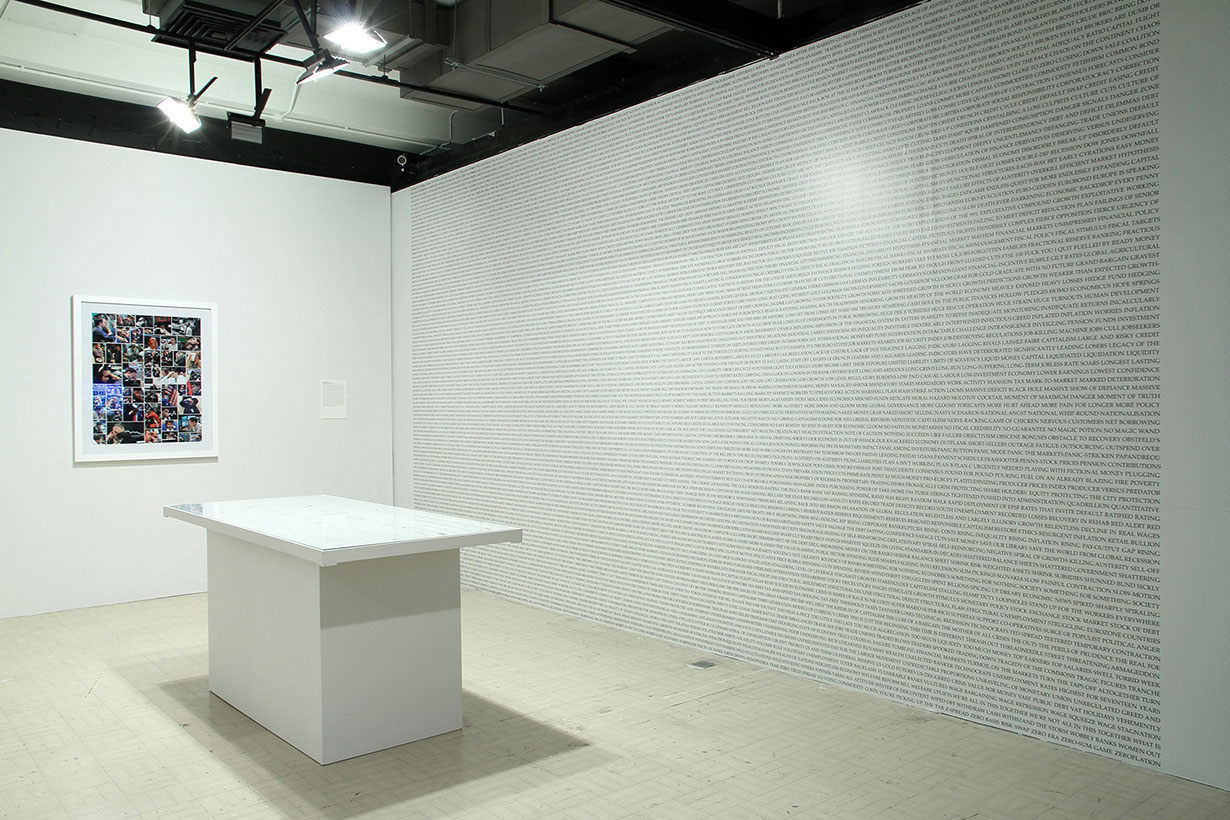
and some other reviews…..
BBC News Online, June 2014. Read here.
The Journal, July 2014. Read here.
Corridor 8, August 2014. Read here.
We English (Chris Boot, 2009) is featured in the third and final volume of Phaidon’s acclaimed Photobook series, described as ‘the most important contribution to the field since modern histories of photography began to appear in the early 20th century’ (photo-eye) by Martin Parr and Gerry Badger.
See more here.
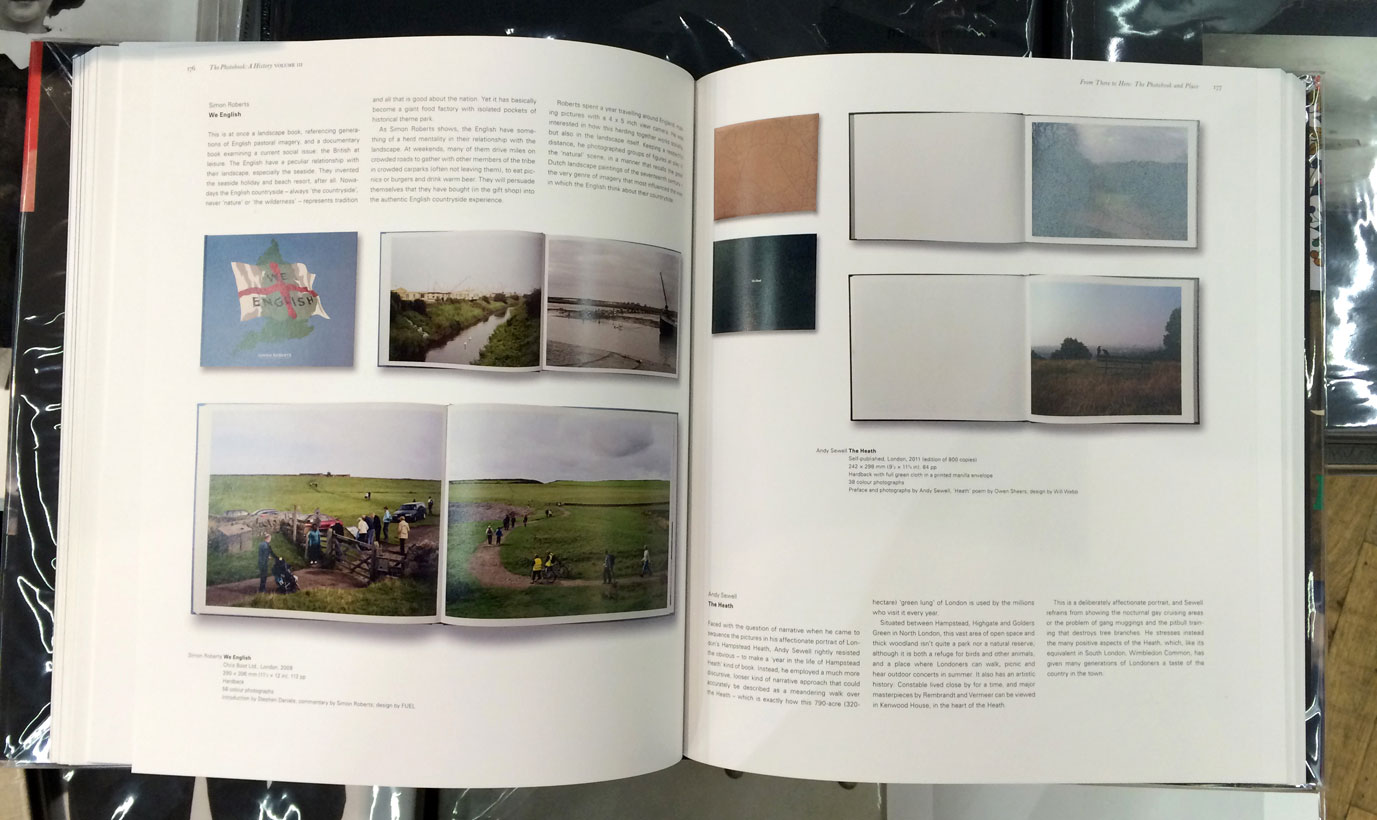

ABOUT THE BOOK
Following the success of volumes I and II of The Photobook: A History, this third volume brings the history of the photobook up to date, with specific exploration of postwar and contemporary examples. It covers key themes including the globalization of photographic culture, the personalization of photobooks, the self-publishing boom and the new ‘layered’ photobook approach.
While the history of photographs is a well-established canon, less critical attention has been directed at the phenomenon of the photobook, which for many photographers is perhaps the most significant vehicle for the display of their work and the communication of their vision to a mass audience. Volume III, co-edited by Martin Parr and Gerry Badger, expands this study and history of the photobook further. It explores the symbiotic relationship between the contemporary propaganda book vs. the protest photobook, sex and youth culture, photographers examining their own environments and the impact of the Internet and social media on the nature of the photobook, among much else.
The book is divided into 9 thematic chapters, each featuring general introductory text providing background information and highlighting the dominant political and artistic influences on the photobook in the period, followed by more detailed discussion of the individual photobooks. The introductory chapter texts are followed by spreads and images from over 200 books, which provide the central means of telling the history of the photobook. Chosen by Parr and Badger, these illustrations show the most artistically and culturally important photobooks in three dimensions, with the cover or jacket and a selection of spreads from the book shown.
Phaidon, 2014
Hardcover
11 3/8 x 9 7/8 inches (290 x 250 mm)
320 pages
900 color illustrations
An article by Stephen Clarke
about my work published in the current issue of the RPS Contemporary Photography magazine.
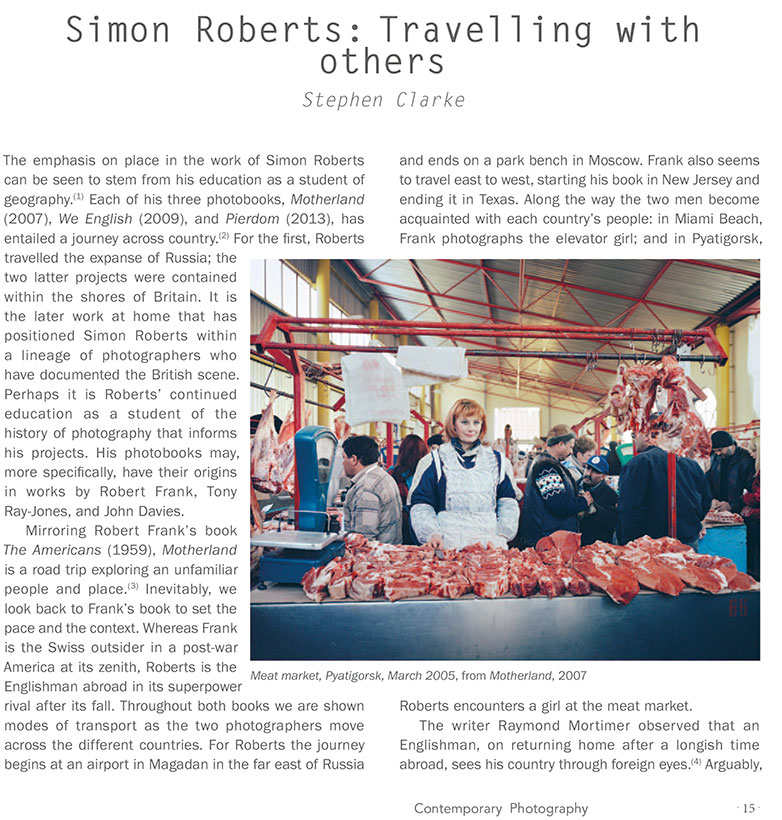
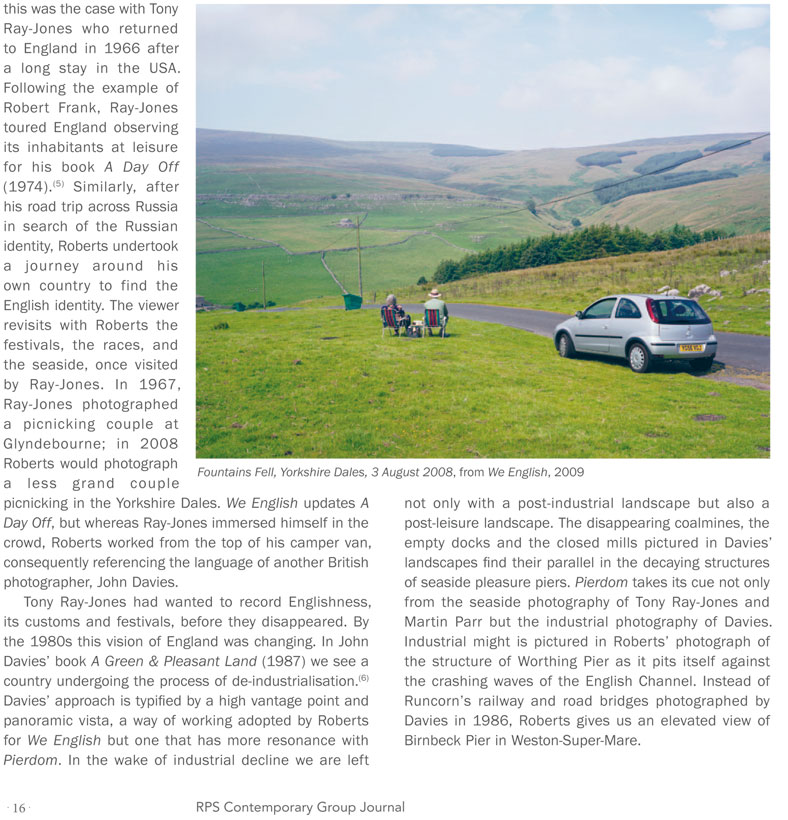
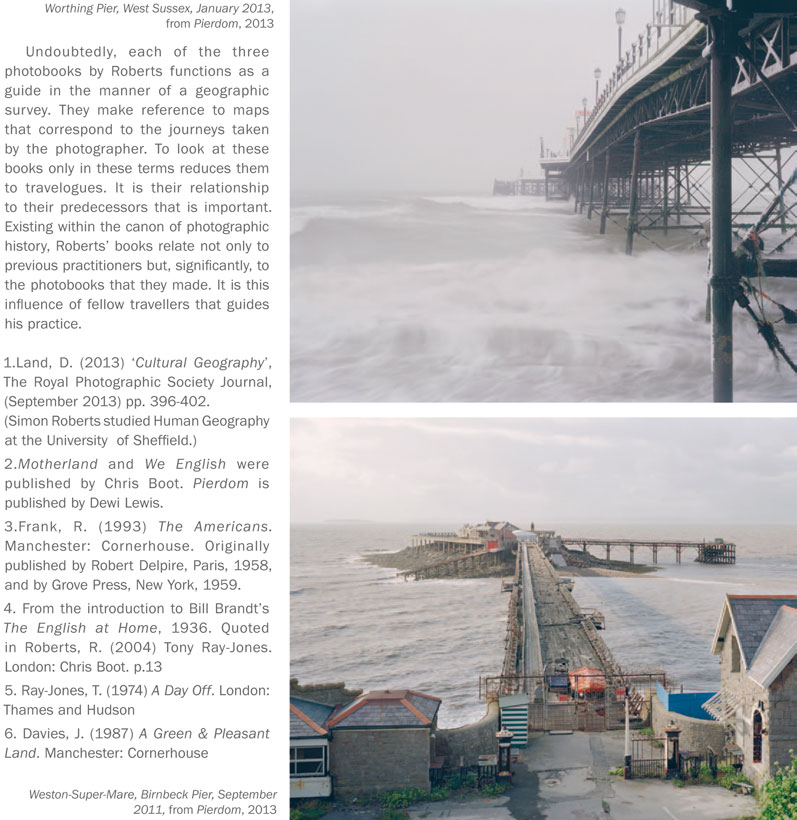
You can download a pdf of the article here.
Pierdom has been reviewed widely in the press since launching in September.
Here are links to a few:
PhotoEye, “Book Review: Pierdom,” 3 December 2013, Jenkins, Karen. (link)
Hotshoe, “Pierdom book review,” Issue 186 / Winter 2013.
Photography & Architecture, “Pierdom review,” 27 November 2013, Graham, Julie. (link)
Photomonitor, “Pierdom review,” November 2013, Atwell, Oliver. (link)
Slow Wear Journal, “Victorian Remains,” 18 November 2013. (link)
Klat Magazine, “Simon Roberts, Pierdom” 11 November 2013, Severo, Fabio. (link)
Gup Magazine, “Pierdom- Book Review,” 30 September 2013, Giostrelli, Sofia. (link)
Fad, “ART STUFF on a train #21: Pierdom,” 24 September 2013, Carey-Kent, Paul. (link)
One Stop Arts, “Simon Roberts: Pierdom at Flowers Gallery,” 23 September 2013, Harbour, Stacey. (link)
The Telegraph, “Review: Pierdom by Simon Roberts,” 29 October 2013, Newman, Cheryl. (link)
Wallpaper* Magazine, “Top shelf: 10 new books to flick through this autumn,” 28 October 2013, Bell, Jonathan. (link)
Morning Star, “Pier Pressures,” 14 September 2013, Hodgson, Francis.
Independent on Sunday, “Photography book review: Pierdom,” 15 September 2013. (link)
Architects’ Journal, “Welcome the onset of autumn with this seaside exhibition,” 9 September, 2013, Pallister, James. (link)
The Observer, “Pierdom: photography book of the month,” 1 September 2013, O’Hagan, Sean. (link)
Time Magazine Lightbox, “The Victorian Pleasure Piers of a British Summer,” 10 September 2013, Harris, Katie. (link)
BBC News Online, “Britain’s Piers in Focus,” 10 September 2013, Coomes, Phil. (link)
Camden Review, “Art Diary: Sea Here,” 29 August 2013, Smith, Amy. (link)
FT Weekend Magazine , “Piers of the Realm,” 24 August 2013, Hodgson, Francis. (link)
Aesthetica Magazine, “Iconic Britain- Pierdom at Flowers Gallery,” Issue 54 / August – September 2013. (link)
Phil Coomes, Tuesday, September 10, 2013
Britain”s obsession with the coast is an understandable one given its geography and naval history, yet the coast also played an important part in the country”s social history.
It was here that millions of workers first enjoyed time away from the tough working conditions of Victorian towns, and any self-respecting resort would require one key ingredient, a pier. Their popularity lasted well into the middle of the last century, but since then, many have struggled to survive the changing holiday habits of the nation, and in some cases natural disasters.
Yet in some way these structures jutting out into the ocean reflect the nation”s one-time desire to spread its influence, for good or ill, around the globe. Today those that still stand have mixed fortunes, with some like Ryde Pier reborn and others still seeking regeneration.
Photographer Simon Roberts has spent the past three years creating a comprehensive survey of Britain”s piers, depicting all 58 surviving pleasure piers along with a handful of those lost in photographs marking where a pier once stood.
Robert”s approach is in a similar vein to his previous work We English, The Election Project and of course XXX Olympiad, shooting on large format cameras to create a formal record. Within the collection are one or two that have a more journalistic feel, a link back to his previous life as a press photographer.
Roberts studied Human Geography at the University of Sheffield prior to taking the National Council for the Training of Journalists (NCTJ) course in press photography, the two disciplines now seeming to mesh well and drive his work forward.
His projects come at an important time for the country and his long term immersion in the subject is to be admired.
Looking back at a piece we ran by Roberts in 2003 about a you realise how much of a journey he has been on. Not in terms of miles travelled, though his work has encompassed the Middle East, a year in Russia and of course the US amongst others, but in terms of developing his own voice through his images.
That”s not something you can do overnight. And though the beauty of these pictures can only really be experienced first hand as large prints on the wall, the smallish reproductions here do offer a glimpse of the eye and brain behind them.
You can see the full article here along with two video clips on location.
Pierdom is Sean O’Hagan’s ‘Photography Book of the Month’ and reviewed in today’s Observer:
“Piers provide a walk on the sea without the disadvantage of being seasick,” declared the poet of all things quintessentially English, John Betjeman, “and are havens of fresh air and freedom which we can ill afford to lose.” Betjeman was one of the founders of the National Piers Society, an organisation that continues to campaign to safeguard the future of the 58 surviving piers in Britain. He would have been delighted with this book.
Pierdom is another instalment in Simon Roberts‘ ongoing visual documentation of modern England. He has photographed every British pier using a 4×5 plate camera, which has also captured the landscape from which they extend, the sea around them and the sky above them.
Roberts has photographed some piers from a distant elevation and others up close from underneath their steel and wood structures. Thus, Deal pier in Kent seem to stretch to the horizon, while Aberystwyth looks like an industrial sculpture. Others, like the “lost” pier of Brighton West or Hastings pier, both greatly damaged by fire, seem like malformed things that may at any moment fall into the sea. (As I write, work has begun on the reconstruction of Hastings pier, but Brighton’s West pier remains lost, though there are ambitious plans to build a towering pier in the sky at its entrance. This does not seem right, somehow.)
Like his previous book, We English, Pierdom is a kind of topography of England and Englishness. There is a similar sense of stillness in many of the large-format landscapes, as well as a sense of the abiding otherness of the English seaside town. Blackpool now looks much like Blackpool then, or is it just the almost Kodachrome colours that make the ornate entrance look oddly old-fashioned? Sandown Culver pier on the Isle of Wight is a different kind of study in muted colour and atmosphere, with a hint of silver sunlight on the horizon where the grey of the sea meets the lighter grey of the sky.
This is a much cooler and detached approach than, say, Martin Parr’s seaside photographs, and shares a certain similarity of style with John Davies‘s documentary photographs of British landscapes. Here and there, though, there are hints of John Hinde’s postcard vision of Britain as one big unreal leisure theme park, especially in Roberts’ wonderful diptych of Walton-on-the-Naze pier.
A homage, then, to the enduring vision of the Victorian pier designers, but also to an England that still values the bracing benefits of “a walk on the sea without the disadvantage of being seasick”. And a very beautiful book from a master of stillness, light and landscape.
You can download a pdf of the review here.
Pierdom is featured in this weekend’s FT Magazine prior to the book and exhibition launch at Flowers Gallery on 10 September.
You can see an online slideshow on the FT website and read an article by Francis Hodgson here.
The magazine spread can be download as a pdf here.
It comes as a new report has been released by Co-Operatives UK on the state of the British seaside pier which you can read here and download as a pdf here.
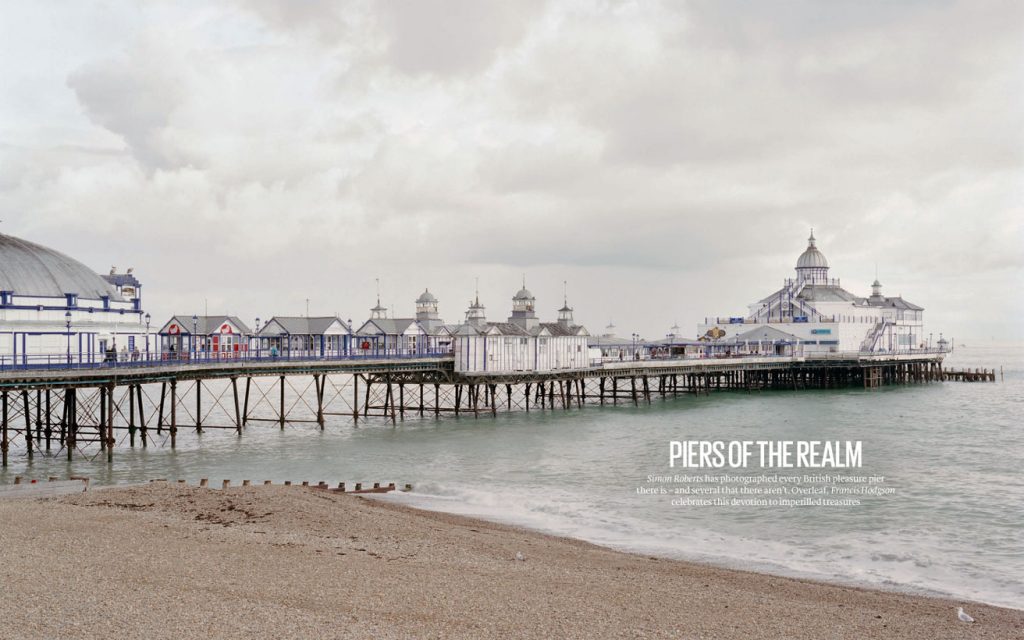
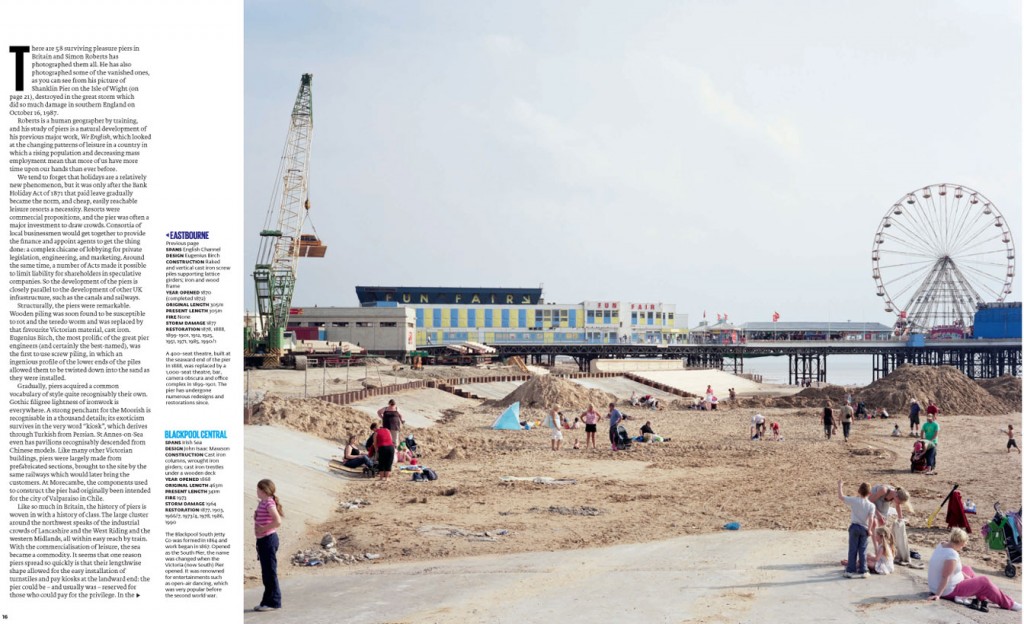
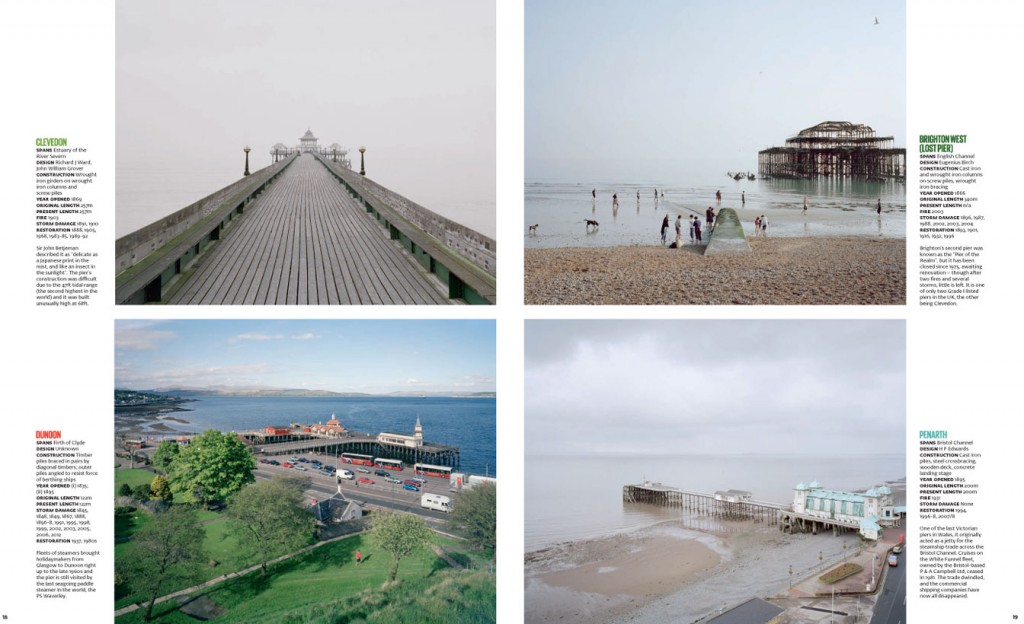
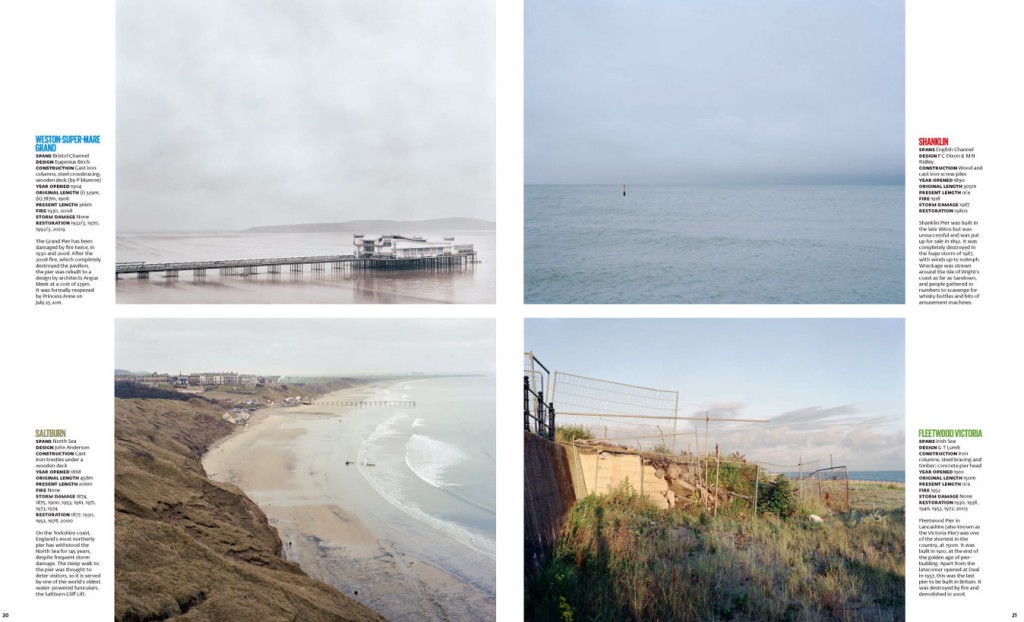
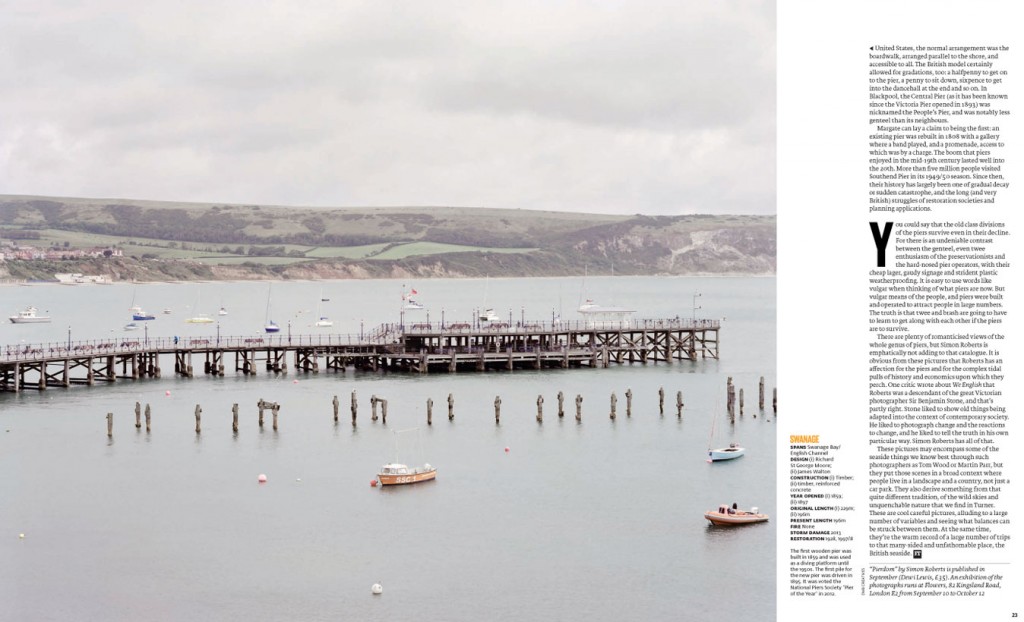
The current issue of Aesthetica Magazine (Issue 54, August – September 2013) features a review of Pierdom under the title ‘Iconic Britain”:
“Roberts’ new exhibition and book of the same name, Pierdom, capture the nostalgia and the altering function of piers….
Acknowledging their importance over time, Roberts compares the original architecture structures with their modern interpretation and usage. For example, his images of abandoned piers such as Birnbeck Pier (2012) are contrasted with those like Ryde Pier (2012), in which the local community and everyday function of the landscape are represented by a skateboarding park that appears at the forefront of the picture. It was this combination of culture and society that caught the photographer’s interest, discovering an ingrained fascination with the relationship between humanity, the surrounding environment and important British pastimes.
Roberts records the symbolic constructs with great technical precision. His images capture peripheral details, which include the surrounding landscape and have the effect of enriching the observation of each work. Utilising formal devices associated with the picturesque, the pieces align audiences with contemporary issues, acknowledging the precarious connection between society, nature and urban environments. Through deciding to survey a small part of British history and Landscape, he is able to undertake an architectural and anthropological study of the country.”
You can download a pdf of the review.
